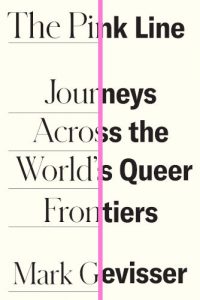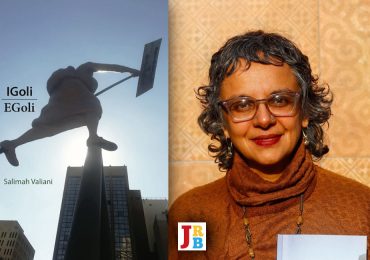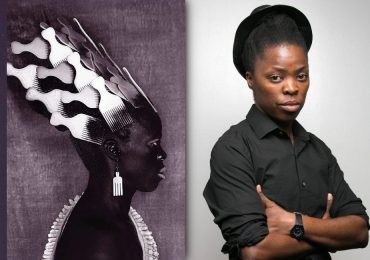Arja Salafranca reviews Mark Gevisser’s new book The Pink Line: Journeys Across the World’s Queer Frontiers.

The Pink Line: Journeys Across the World’s Queer Frontiers
Mark Gevisser
Jonathan Ball Publishers, 2020
Asked what he hoped to achieve with the publication of The Pink Line at the book’s online launch in August 2020, Mark Gevisser said: ‘I want to expand people’s minds, and my own mind.’
That was exactly my impression having finished the book. It contains a substantial journey among a number of queer and transgender people from South Africa to Egypt, India to the United States, Mexico and Russia. Gevisser tells their stories in alternating chapters in which topics such as transgenderism and changing attitudes to queerness around the world are explored. My mind was expanded, it bulged with the stories of those who have had to navigate difficult pink lines in their life journeys.
‘The stories I tell don’t always end on a high note,’ Gevisser added, and indeed many of the stories of those who have fallen foul of anti-gay laws are tinged with bittersweetness, even when the endings are successful, so to speak.
The Pink Line, as Gevisser explained during the launch, ‘runs through countries and divides people’. In the book, he writes:
‘It is a place where queer people shuttle across time zones each time they look up from their smartphones at the people gathered around the family table; as they climb the steps from the underground nightclub back into the nation-state. In one zone, time quickens, in the other it dawdles; spending your life criss-crossing from zone to zone can make you quite dizzy.’
This, then, is both a physical journey and an exploratory, cerebral one, through the often shifting pink lines.
Gevisser travelled from 2012 to 2018,
‘trying to understand how the world was changing, and why. I did not go everywhere. Rather, I chose places where I felt I could meet people who could best tell the story of how the “LGBT rights movement” was establishing a new global frontier in human rights discourse—in the way that the women’s rights movement, or the civil rights movement, or the anti-colonial movement, or the abolitionist movement, had done in previous eras.’
The story begins close to home, in Tambo Village, a township outside Cape Town, where Gevisser lives with his husband. This is now home to Malawian exile Tiwonge Chimbalanga, who calls herself Aunty. Assigned male at birth, she early on took on traditionally female duties in her uncle’s household where she grew up, cooking and cleaning, and he accepted her as female. In 2009 Aunty made world headlines when she held an engagement ceremony called a chinkhoswe, with her partner, Steven Monjeza. They were arrested and charged under Section 153 of the Malawi Penal Code that forbids homosexual sex. Aunty was adamant that she was not gay; she saw herself as a woman and explained her male features away with the assertion that she had been bewitched as a child. She and Monjeza were sentenced to fourteen years of hard labour.
The international condemnation that followed resulted in a pardon from the Malawian president, Bingu wa Mutharika. Aunty and Monjeza broke up. She applied for asylum in South Africa, and it is in her home in Tambo Village that Gevisser gets to know her and tell her story. Now living with a new husband, Benson, a fellow Malawian, Aunty suffers derision from others in the township—it is still a tough world for her, despite her asylum status. She has suffered assault, and has struggled to fit in. Benson too, is not the ideal partner, with his drunken rages, but Aunty, it seems, is made of steel, and has made a life for herself on the edge of Gugulethu.
Michael Bashaija’s story is another of exile, first to Kenya, after having been driven out of Uganda. His family discovered his relationship with a classmate, and froze him out of the family home. He was to make his way to Kampala, and then to Canada. In a wry twist, Gevisser notes, before the promotion of anti-homosexuality legislation, Uganda had been ‘home to the most open scene in East Africa’. Telling the story of the Pink Line is not so simple, and understanding how homosexuality is understood around parts of the world isn’t a cut and dried exercise.
Before Bashaija found his way to Canada, he too walked a rocky path. He suffering abuse at the hands of others, from a man who had sex with him before turfing him out of his home after a few weeks. He was kicked out of the mosque where he next found shelter. Then he was taken in at a Christian orphanage and boarding school, but he was again ejected, as being gay ran counter to the beliefs of those running the school. Further homelessness, and further abuse followed. Finally finding asylum in Canada, it’s clear that the path of exile and beginning again isn’t easy: ‘I thought people would be welcoming, but they push you away indirectly.’
Another story is that of Maha and Amira from Cairo. When Gevisser meets the couple, Amira owns an establishment called Girls’ Café. The two have been married, although illegally. It is a year after the Arab Spring and Cairo’s downtown is buzzing. Amira has left home, after having been discovered with a girlfriend by her mother, and lives in a flat. Maha stays overnight with Amira only a couple of nights a month; she lies to her parents about needing to travel for work. But Egypt is still not a safe space for queer or transgender people. Amira’s bar is trashed. The police use online platforms to entrap gay men. In 2014 Amira is forced to flee the country and the couple spend years apart trying to be together. They find asylum in Holland; but their relationship has crumbled, and Maha finds that life in a ‘free’ country has its own unseen emotional locks and chains.
Meanwhile, in Russia, Pasha Captanovska loses custody of her son to her ex-wife, because she is transgender. She has violated the Federal Law on Protection of Children from Negative and Harmful Information ‘which prohibits the propaganda of non-traditional sexual relationships among minors’. Pasha is yet another victim to the dividing lines of the Pink Line—her being transgender is not the problem here, but words are words, it’s the actions that drive them that can destroy a life. She is not permitted to see her son until he turns eighteen.
In Mexico, married lesbian couple, Martha and Zaira, spend years trying to get Martha registered as a second parent to their child, Sabina (born to Zaira). It is a struggle that goes on for years, and highlights negative attitudes toward queer people in their country; even though same-sex marriage was legalised in Mexico City in 2010, same-sex marriage is only legal in some states.
Gevisser also explores the politics of transgenderism in communities in the US, meeting Liam Kai who is a transgender man, undergoing top surgery in 2014. Liam has lived as a boy since he was thirteen, binding his breasts, but could do nothing more until he reached eighteen. Why? Because his lesbian parents disagreed. Beth accepted Liam’s transgender identity; Susan was opposed. They no longer lived together. This riveting chapter illuminates the plight of a transgender people, and the differing arguments for and against allowing transgender children to choose their preferred gender, with some people believing that because being transgender is now so easily accessible some impressionable teens could adopt another gender before they are properly ready to do so.
Gevisser also spends time among the ‘kothis’ in India, ‘men with women’s hearts’, meeting a group who run a temple in a rural fishing village. There is also his sharply draw portrait of the relationship between a Palestinian man, Fadi, and his Jewish boyfriend, Nadav.
Interspersed between these stories is considerable research into the subject of how the world is divided by the Pink Line—between those countries that have and are decriminalising homosexual activity, and others that are strengthening their laws. Some of the facts are astonishing to read about. In countries where it is assumed more liberal attitudes prevail, there are still anomalies. In 2017 seven American states still had ‘no promo homo’ laws on their statute books. In the United Kingdom, Margaret Thatcher’s Section 28 amendment, which forbade local authorities from promoting homosexuality in schools, was only repealed in 2003.
Then there are the arguments that the Western world has forced ‘identities of gayhood’ onto other cultures in their desire to see queer-related human rights violations stamped out. Palestinian academic Joseph Massad, a professor at Columbia University, published an essay in 2002 in which
‘he argued that Western human rights activists and tourists alike had disrupted age-old modes of homosexual activity in the Arab world by foisting the “gay” label onto them. This, he maintained, had forced an unspoken but widely accepted practice into the light of day, and demanded that a set of rights be attached to them.’
And then there is the generational divide, as illustrated by Indigo. Taken by her bisexual mother to Michigan’s Womyn’s Music Festival since was a child, she has struggled with their policy of excluding transgender women: ‘We are more fluid. Less bothered by categories. That’s what makes us queer.’
The Pink Line is a tour de force of scholarship into the lives and issues that affect queer people today, opening a window on lives that are still so often marginalised, and a riveting account of Gevisser’s own exploration into these worlds.
- Arja Salafranca is the author of a debut collection of short fiction, The Thin Line, and three poetry collections, the most recent of which is Beyond Touch. She has edited anthologies and holds an MA in Creative Writing from Wits University. She lives in Johannesburg.





